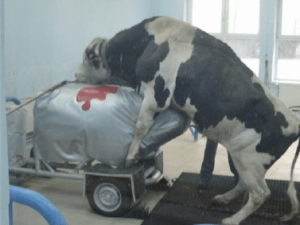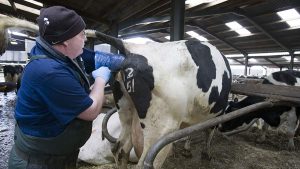Artificial Insemination- Technique and Application
Artificial insemination is the introduction of sperm into a female’s cervix for achieving a pregnancy through in vivo fertilization by means other than sexual intercourse. It is a common practice in animal breeding, including dairy cattle, sheep, and pigs.
Artificial insemination (AI) is the process of introducing sperm cells from a male animal and manually depositing them into the reproductive tract of a female. Apart from natural mating, AI is commonly used in many species of animals as it provides many benefits like increased safety of the animals and producer, increased production efficiency and better genetics and can reduce many of the risks involved with breeding.
Artificial insemination removes all risks involved with keeping a male on the premise/farm, reduces the risk of transmitting diseases. The entire artificial insemination procedure is much more hygienic than natural mating. All the tools and equipment are sterilized both before and after the insemination.
Artificial insemination of farm animals is common in the developed countries, especially for breeding dairy cattle. Swine are also bred using this method. It is an economical means for a livestock breeder to improve their herds utilizing males having desirable traits.
The first scientific research in AI of domestic animals was conducted on dogs in

Why Artificial Insemination?
- It allows several female animals to be impregnated from a single male.
- To allow the use of genetic material from males separated by distance or time,
- To overcome physical breeding difficulties,
- To control the paternity of offspring,
- To synchronize births,
- To avoid injury happens during natural mating,
- To avoid the need to keep a male at all, and
- Artificial insemination can drastically improve the genetics of your herd.

Technique and Application
- Semen is introduced in uterus by mechanical methods at proper time and under most hygienic condition.
- Semen is collected, extended, and then frozen. Though, it can be used on-site or shipped to the female’s location. If frozen, the small plastic tube holding the semen is called a straw. In order to allow the sperm to remain viable during before and after it is frozen; the semen is mixed with a solution containing glycerol or other cryoprotectants.
- An extender is a solution that allows the semen from a donor to impregnate more females by making insemination possible with fewer sperm.
- Antibiotics, such as streptomycin, are sometimes added to the sperm to control some bacterial venereal diseases.
- There are two methods of freezing and storing semen: Dry ice & Alcohol (-100 0F) and Liquid Nitrogen (-320 0F).
- The artificial vagina assembled is held at 45 0 angle from the direction of penis, and the thrust is that angle.
- The proper timing of insemination for achieving good result is as the cow showing estrus in morning should be inseminated same day, if showing estrus in afternoon should be inseminated next day in the morning or early afternoon.
See also…
SYSTEMS OF BREEDING- DIFFERENT METHODS